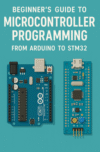Debugging embedded systems can be a challenging process, often requiring both hardware and software expertise. Small mistakes can cause large and confusing failures, and without a systematic approach, hours can be wasted chasing the wrong problems. This expanded checklist provides more context, explanations, and best practices to help you diagnose and resolve issues efficiently.
🔍 Hardware Pitfalls
- Loose or incorrect wiring: Misplaced jumper wires or slightly loose connectors can create intermittent problems that mimic software bugs. Always verify physical connections with a continuity tester before moving to software checks.
- Power supply instability: Embedded systems are sensitive to voltage fluctuations. Use a multimeter or oscilloscope to check for dips, noise, or unstable regulation that could cause resets or erratic behavior.
- Floating inputs: Inputs left unconnected can pick up random electrical noise, leading to unpredictable operation. Always use pull-up or pull-down resistors as specified by the design.
- Clock issues: The stability and accuracy of your microcontroller’s oscillator affect all time-dependent operations. If your system is behaving erratically, ensure the crystal or clock source is functioning correctly and matches firmware settings.
💻 Software Pitfalls
- Uninitialized variables: In embedded C/C++, failing to initialize variables can lead to random startup values that cause inconsistent behavior. Always assign initial values explicitly.
- Incorrect peripheral configuration: Cross-reference your code’s settings with the datasheet or reference manual. A wrong baud rate, timer setting, or pin mode can completely halt communication.
- Blocking code in ISRs: Interrupt Service Routines should be minimal and fast. Long loops or blocking calls here can delay critical tasks and destabilize real-time performance.
- Memory leaks or stack overflows: Embedded systems have limited RAM. Monitor memory usage with debugging tools and use stack guards or monitoring functions to detect overflows.
🛠 Debugging Techniques
- LED indicators: Use blinking LEDs to convey different system states. For example, slow blink for normal operation, fast blink for error state.
- Serial logging: Print debug messages over UART to observe system behavior in real time. Timestamped logs help identify when problems occur.
- Logic analyzers/oscilloscopes: Capture and analyze signals to verify timing, voltage levels, and communication protocols.
- Breakpoints & watch variables: Step through code with an in-circuit debugger, inspecting variables and peripheral registers to pinpoint where things go wrong.
🚫 How to Avoid Issues
- Create a test plan: Outline hardware and software test procedures before starting development. This ensures systematic troubleshooting.
- Use version control: Keep track of every firmware and schematic change so you can roll back to known-good states.
- Synchronize design files: Keep schematics, PCB layouts, and firmware aligned—outdated design files can cause mismatches.
- Document debugging sessions: Record what tests you ran, what results you observed, and what changes were made. This prevents repeating failed approaches.



